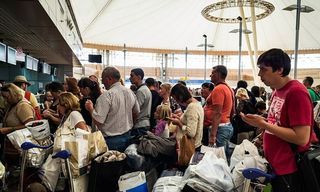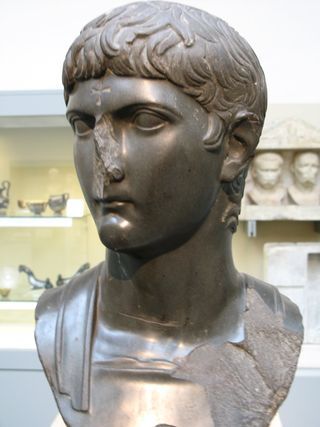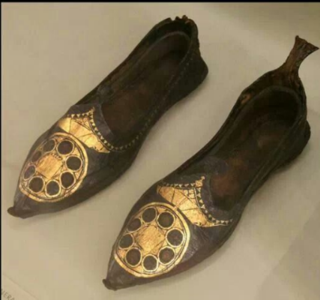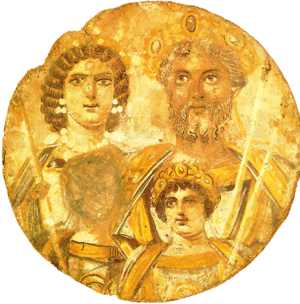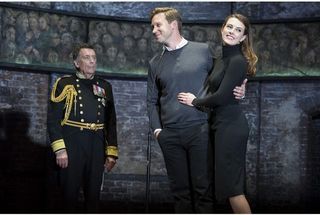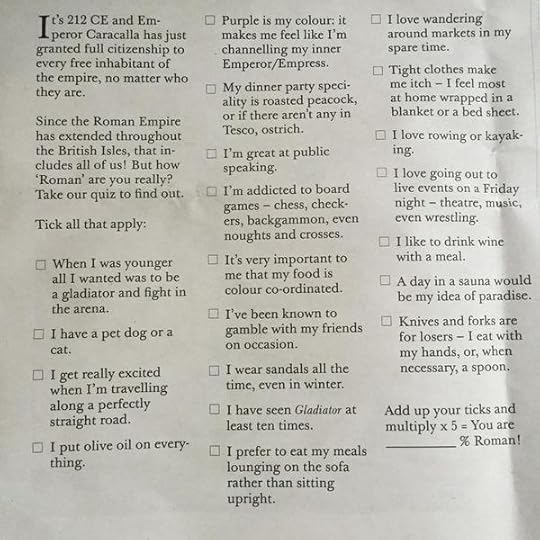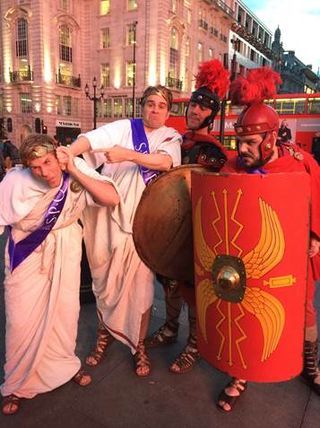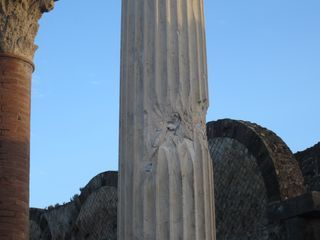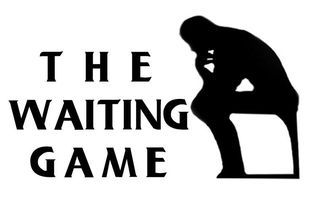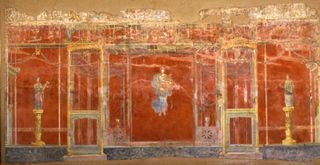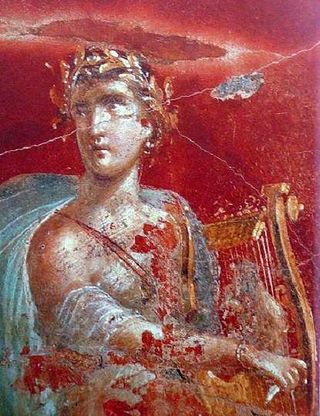Mary Beard's Blog, page 19
November 11, 2015
Electronic locks
OK, I am allowed occasionally to have a good-humoured moan about domestic irritations. One of those is electronic locks -- to which my place of work is going over almost entirely, if it hasn't done so already. An ordinary key will soon I suspect be a thing of the past, not to mention a door without some kind of built in opening and closing device.
Our faculty building has long had "key" pads on almost everything, operated with your university card, plus on the main front door some kind of opening and closing device worked by a push button. The advantages are fairly clear: no rushing down to the key-cutters to get keys made; people can be given access or denied it electronically (without asking them to come in and hand back their keys when they leave or disgrace themselves); and I imagine (though I dont know this) that the system records every person to whom access is granted, date, time etc.
But so are the disadvantages, though they are not so often talked about: if you lose or mislay your card, you are instantly locked out of everywhere (that may be relatively easily fixable Monday to Friday, but not on a Saturday morning); and the front door of our faculty at least is now so heavy and slow moving in its automatic operation that there is plenty of time for an intruder to slip in behind you if they are determined (with an old-fashioned key, you pulled the door directly shut and locked it -- simple).
But now my college is moving that way too. The truth is that Cambridge colleges are still a bit more attuned to the individual preferences of old-fashioned ladies like me, and it doesn't look like I will be forced to have my actual key replaced by one of the things illustrated above (thanks Cheryl and Wendy, and thank heavens).
They are advertised in a frighteningly "1984 style" website that proudly blazons the slogan:
"WITH SALTO XS4
SAY GOODBYE TO MECHANICAL KEYS"
And the special features they advertise specifically for educational use include:
"SALTO AMOK electronic escutcheons have a built-in card reader on the inner escutcheon. This inner reader enables users to activate the AMOK function mode in order to lockdown a room quickly. Only authorized users with AMOK privileges on their access plan can activate it."
Whatever that exactly means, I am sure it would be fine, unless you happen to like mechanical keys. And in this case, the added disadvantage would be that this monstrosity would be going on a lovely Victorian door, and -- as it is now self closing (fire-regs) -- I assume I would never be able to leave the room open, and would have to make sure I took my card each time I popped out to the loo (though maybe the loo will soon be "escutcheoned" too). I suppose I would just end up wearing the card on a lanyard all the time, which is now the ball and chain of the office worker.
But it could get worse. Just wait till we are being sold electronic access systems for our houses. "Sorry, madam, no call for actual keys these days".
November 7, 2015
The Sharm el Sheikh problem
History works in at least two ways. It helps us see ourselves differently in the light of the past. And it makes us reflect on how we will appear in the future when we have become the past.
And that is always a useful exercise for students: what do you imagine the students of the future will write their essays on when they come to write about us. What will puzzle the future about us? Over the past few years I have think I have already touched on some of those future essay topics.
My money is certainly on the twentieth and twenty-first century prison system as the launch pad of many a future essay and post-graduate dissertation. I can more or less write the essay question now. ���How do you explain the fact that successive British governments between 1945 and imprisoned increasing numbers of non-violent and non-dangerous offenders despite the huge cost and the statistics on re-offending?���
The same will go I suspect for our care of the elderly. How on earth will our deplorable record on care homes look in a couple of centuries. I suspect that our descendants will be talking about them much as we talk about the workhouses.
But, reflecting on the last week's events in Egypt, I think there is another rather different topic too.
That is: tourism to sunny climes. How is it that in the UK (and elsewhere) we all came to think that a safe holiday somewhere foreign IN THE SUN was part of almost everyone���s entitlement, no matter the local geo-political dangers? And how is it that so many countries who just happened to have wall to wall sunshine came to invest their whole economic futures in tourism (which can be disrupted, even finished, for years with a single (suspected) bomb), instead of in actually making or growing things ��� or even, much as I hate them, call-centres.
There will be some students who will rightly discuss the class changes here. Of course the privileges of summer sun, long enjoyed by the toffs in the UK, were in due course properly claimed by the less wealthy too. Could people really have imagined that it should continue to be the rich only who swapped rainy Britain for a Mediterranean beach when they wanted and deserved a break?
No, absolutely not. But the gap between that and the moral outrage of the press at the ���plight��� of ���holiday makers��� is hard to take. I feel sorry for them too but they have gone to Egypt for heaven���s sake. Haven't they read a newspaper? Haven't they spotted, or has noone told them, that Sharm El Sheikh is a tiny enclave in a sea FCO 'dont go' areas? Too much money for the tour companies is at stake for anything like that.
And on the other side of the picture, there will be plenty of those future students who will rightly talk of late capitalism, and of the exploitation of poorer countries by richer ones, when they point to an economic prosperity based on a ���industry��� (that is ���tourism���) that can simply disappear overnight.
Does any of this make good sense? Come back Skegness?
November 6, 2015
The Laughter Business
I am not usually such an avid theatre goer, but after King Charles III, last night we went to see Mr Foote's Other Leg on an overnight in London. It was one of those lucky chances. It had had excellent reviews on its first run in Hampstead, directed by Richard Eyre and starring the excellent Simon Russell Beale, and resurrected a famous Georgian theatre man, contemporary of Garrick, the one legged Sam Foote.
It was a great evening, but I hadn't realised that (to return to one of my old big interests) it was in many ways about LAUGHTER -- how you prompt it, at what cost, and the relationship between comedy and tragedy, laughter and tears. So great food for thought for me, but not just on the stage.
What was really striking was the audience reaction. They were laughing away from the very first, engaging but not hugely hilarious line. This irritated the husband more than it irritated me, but it did rub in how often (genuine) laughter is produced by the knowledge that that is what one is expected to do... you have come out for an evening of communal laughter, so that's what you do.
Comedians must know all about this, and how to exploit it. But last night was for me an extremely instructive example of it.
And at an opportune moment.
Just when I have been having some lovely reviews for SPQR, I had a timely warning against a big head and complacency by a real fully frontal attack on what I guess was the paperback edition of my Laughter book in the New Criterion. Now I am all in favour of critical reviews, have written a fair few in my time, and am rather of the opinion that some of the most innovative books should actually provoke specialist criticism -- if everyone else in the field agreed wth them, start to finish, they probably wouldn't be innovative. But when you find not much more than a barrage of assault and innuendo (from someone whose work -- in this case on joking and humour -- you actually read but decided not to mention), and when you really have discussed a load of things that you are supposed to have omitted, you do suspect something else is going on.
Here it is. But for those who can't face it, this is the last paragraph:
"I have spoken little of Beard���s obvious erudition; that is a matter for the classicists who are more expert in the field than I am. What I would say to the classicists is that in the area where I do have expertise, the analytical study of jokes and humor, it is clear to me that she is often talking nonsense. They should take this into account when assessing the validity of her scholarship in other respects."
It comes in as a close second to a fuming review a few years ago of my Jane Harrison book. It was in the extremely austere classical periodical Gnomon, and complained about my interest in Harrison's sexuality and in fact quoted my question "Was Jane Harrison gay?"
Hang on, I thought; I never asked that and anyway think it is a really stupid question.
Sure enough I hadn't asked it. When I nervously checked, what I had actually said was: "Was Jane Harrison gay?' is a question that this book hopes to transcend. Caveat lector.
November 1, 2015
What's happened to all the currants in town?
Every now and then someone on Twitter, either innocently or mischieviously, gets me and the lovely Mary Berry mixed up. "I cant stand that Mary Berry droning on about the Romans" or whatever. The truth is there are only two days in the year when I even approach Bake-Off territory: one Sunday in November when I bake the Christmas cake, and another when I steam the Christmas puddings.
Today I opted for the cake, largely because it doesn't require such constant attention while I am trying to write a lecture (making sure the damn pans dont boil dry -- else all the work is ruined -- is edgier than just shoving a cake in the oven for four and a half hours).
The problem turned out to be the ingredients.
My faithful recipe (Delia, actually) specifies 1lb of currants, and 6 ounces of both sultanas and raisins. Both the sultanas and raisins arrived from the on-line grocery order, but no currants. The husband generously offered to do a trawl of the local supermarkets, with similar results. Sainsbury's had both raisins and sultanas but no currants, likewise the Co-op and the neighbourhood Pakistani omnium gatherum; Aldi was the same (though the girl asking 'what are currants?' didn't inspire much confidence in her ability to track the things down). Eventually,after trying another Co-op, I found a few precious packets in the Derby Stores in Newnham village (I say this for the benefit of anyone else on the hunt).
The puzzle is where have they all gone. Was it just bad luck? It seems unlikely that there has been such a flurry of Christmas baking that the currant stocks had been suddenly depleted. The husband began to postulate a European economic cause. Currants should come from Greece. So had the crisis affected the crop, production or transport? Suspiciously my find in the Derby Stores had the ominous word 'produce of more than one country' on!
So I hope they are decent after all. Every year the family finds it in themselves to say, ''We really do think this is your best one yet". But presumably that ever upward progress cant go on for ever.
October 30, 2015
Faith after the Pharaohs
I had a quick look at the new exhibition at the British Museum, this week: Egypt: faith after the pharaohs. It's got some big and topical themes, looking at the relationship there between Christianity, Islam and Judaism between 30 BC (when Egypt became a Roman province) and 1171 (the end of the Fatimid dynasty).
One of the symbols of the show is the basalt bust of (probably) the Roman prince Germanicus, with a cross carved into his forehead. But there are all kinds of other treasures both local and from further afield. The Codex Sinaiticus, for example, the earliest complete text of the New Testament, has made the trip from the British Library down the road.
But for me the most striking objects were all those things that survive so well in Egypt in the hot dry conditions and we rarely see elsewhere.
This (above) is part of some sixth to seventh century AD curtains, which had been re-used as a burial shroud and interestingly even at this date still feature distinctively classical motifs. And overall there are more early textiles in this exhibition than I have ever seen in one place before (one case, for example, shows three children's tunic side by side, almost like a late antique shop front).
There are also some entirely unexpected children's toys (a reminder of how many there must once have been): a first or second century AD rag doll, and a little toy horseman from a couple of centuries later. 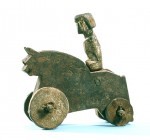
And for those who like shoes, there are a few fine specimens, some cute children's sandals and a rather dashing pair of gilded shoes that deserve a come back.
And, looking at the excellent catalogue, I see something I missed that I will go back for: the famous painted panel of Septimius Severus and his family, which I highlght in SPQR. I saw it years ago in Berlin, but haven't set eyes on it in the flesh for years (it's the one where the figure of the unfortunate murdered Geta has been rubbed out).
So it will be back to the exhibition for me.
PS... it turns out that I wasnt as unobservant as I feared; the Severan portraits, though in the catalogue, couldnt actually travel to London. Even so, it's worth another trip -- not just for the big ideas, but for all the little surprises.
October 25, 2015
King Charles III
We had a rare 'evening out' last night, in the 'evening entirely for pleasure' sense. We went to see Mike Bartlett's 'King Charles III' at the Cambridge Arts Theatre.(The play is currently on tour for us out-of-London types.) It has been hugely well reviewed, and we didn't think it quite came up to the hype, but still well worth seeing if it comes near you.
The plot, I guess. is well known (though I wont spoil the end). It is set just after the funeral of the present Queen, and Charles who has waited so long for the throne almost instantly goes head-to-head with the Prime Minister, refusing to sign off (that is give 'Royal Assent' to) a new piece of legislation restricting freedom of the press. Most of the main royals are there, including Harry who is now negotiating his role as the spare by having a dalliance with a young Republican art student -- who is, predictably, being unfairly pursued by the press.
It is all scripted in sub-Shakespearean blank verse, and full of clever little allusions to Shakespearean tragedy. And that works extrordinarily well. The problem for us was that, in the end, the political bite was rather muffled, and the point was just a little unsurprising, as you'll see if you go to see it.
Afterwards, we found ourselves talking about two things.
The first was about verisimilitude, in a play featuring people whose images we see all the time. What makes them plausible? There was something about Robert Powell's Charles that didn't quite convince, despite some excellent mimicking of the royal intonation. On the other hand Kate felt like a spitting image of the real Kate -- even though as you can see in the picture above, she wasn't. The hair and posture were really what did it, as well as the walk. And that was the same with the ghost of Diana, who flits across the stage on a couple of occasions: a perfect gait!
Then there was the intriguing figure of Kate, who for all the plastic doll image (a phrase she quotes) turns out to be a steely manipulator, responsible behind the scenes for the final outcome. In a way, it's a classic example of, when in doubt, 'blame the woman'. In the Shakespearean context, she is the Lady Macbeth. I couldn't help seeing her as the Empress Livia!
October 23, 2015
Me and my centurion
I have always been a bit wary of stunts at book launches, or anything else for that matter. But I have to say that I rather enjoyed what my publishers, Profile, did to launch my SPQR. First of all, there was an extremely friendly centurion keeping a watch over the proceeding at the Society of Antiquaries, and guarding the front door. (That's him above with me and Andrew Franklin.)
And they had also printed a spoof Roman (tabloid) newspaper for people to take away, all rather expertly filled with stories taken from the book itself. Here is just one highlight (in response to Caracalla's citizenship edict of 212 AD):
But the following night, at Waterstones Piccadilly, they went one better.
In marvellous bit of street theatre, rarely seen in Piccadilly, a dramatisation of the first part of Cicero's first Catilinarian speech was staged -- much to the amusement of passers by. In the picture, you can see the burly Cicero, taking the unfortunate Catiline (desperately protesting his innocence) by the scruff of the neck.
And it was these guys for company, plus a couple more Roman soldiers, that we kicked of the first official day of sales, with a discussion (guided by Peter Stothard) on what 'SPQR' really means, why Rome matters, how you write its history -- and so on.
A jolly good time was had by all. And if you missed it, there's another London event next week at the Royal Geographical Society on Wednesday 28th at 7.00 pm.
So far, so good.
October 17, 2015
More news from Pompeii
People have been in touch since my last post to say.."well, yes, but there IS a large amount of scaffolding about the town, which does sometimes spoil the view and takes away that 'stepping back in time' feeling!'
True, I admit that in places it appears that the builders have moved in, but this is part of an on-going project which is restoring a large number of houses, bringing them back to life -- and with the aim of soon opening them to the public, some such as the House of Joseph II, for example, have been off limits for safety reasons for ever, so far as I know. An enormous amount of careful work restorations is going on, plus some limited evening opening and special disabled access days and so on.
Yet everyone still likes to have pot shots at the administration of the place. This happened again in Italy earlier in the week when south and central Italy was deluged with torrential rain, so bad that several people were drowned at Benevento. Unsurprisingly, there was some water-logging at Pompeii, including parts of the House of Julius Polybius being flooded -- and here is another report.
Instant cue for the Italian chattering classes, at least, to be up in arms: more damage to the precious site.
OK, it is not what you would want to happen, but anyone who thinks that it is possible to keep water out of a 2000 year old house, in freak storms that actually drowned people just over 60 miles away is a fantasist.
As I have always said, unless we start to realise that Pompeii is a jerry-built town, destroyed by a volcano, fairly roughly excavated for many years, then bombed by the allies in World War II, we will never get things in proportion. Just keeping the place standing in more or less its present condition is a superhuman and extremely expensive task, which all things considered is now being done quite well.
Just to remind you of the allied activities (in search of enemy troops believed to be hiding out there), the photo at the top is the shrapnel damage to one of the columns in the forum, and below is where one of the missiles fell nearby. Or to put it another way: if you have ever wondered why there is a capacious cafe on the site, the answer is simple. What was originally there was bombed so badly that it could not be rebuilt and a restaurant built there instead.
October 13, 2015
Waiting
I would like to be writing this blog about something else, but the truth is that as long as I've been writing A Don's Life, I have been keen to choose subjects that are actually on my mind. In a way, for a better or worse, it's been more of a public diary than a series of essays.
So I am not going to pretend that there is currently anything much else is on my mind, apart from the imminent appearance of my SPQR. I have kept you in touch with progress throughout the writing of this book, and you have had a bit of a relief from this as the whole thing has been in production.
But now I actually have a few copies and am waiting for it to be judged. It is a strange feeling of limbo: about as close to waiting for exam results as anything else I know.
You have done your best, put all the work in, written as hard as you could, and now all you can do is wait to see what you get. And it is better not to reflect too hard on what you actually said in the papers, because you are bound to find -- or imagine -- a whole litany of mistakes. It's better just to wait and see how the examiners reckon you have done.
And so it is with the book. How are readers and reviewers going to judge it? There's nothing you can do now. So it's better not to open your brand new copies for fear of finding some of the errors that there MUST be. I have yet to discover a book without a typo. How this can be, I just dont know. In my case, at least, more the five really sharp-eyed people had read the proofs -- and still, when I waved a page at one of my best friends almost at the last minute, he spotted a glaring little error in one of the captions. And I don't believe that I am any worse in this respect than anyone else. Actually, it's the caption that probably gives the game away -- any text that goes into the book late in the process of composition is more likely to have typos that what's been there from the first layer.
And, as another wise friend observed, the mistakes beyond typos are more likely to be in what you know well rather than in the less familiar territory. Because it's in your specialist subject areas, where you feel confident, that you dont check and double check and the lapses happen. In my case that means I am more likely to commit errors in the order of the career of Cicero than in the order of battles of the Hannibalic war.
But, of course, all this is to be hung up on detail and in its way self-protective. What really counts (within the normal standards of accuracy -- I'm not trying to downplay howlers) are the big arguments, and not so much whether readers agree with them all (though I sure hope that many do), but whether readers think they they are really worth engaging with.
That's like exams too, of course. The waiting student fixates on all the little errors they may, or may not have made. The examiner tends to be forgiving on that score, in 'essay papers' at least (not talking translation here). What they are looking for is well informed, clear and sophisticated arguments.
October 10, 2015
New things at Pompeii
People tend to romanticise their first visit to Pompeii. It was always less crowded than their second and more houses were accessible than on their second. I certainly do anyway, with plenty of circimstantial embellishments (like the slightly leery old custodian, who offered to open up the wooden case that then -- it was 1973 -- covered the famous painting of the phallus weighing at the entrance to the House of the Vettii).
Some of this might be true. But in some ways anyone who comes to Pompeii today will have more to see not less.
Pride of place must go to the wall paintings from the Roman 'hotel' discovered at Moregine near Pompeii in the late 1950s.
It's called a 'hotel' because it has five identically planned, large and in parts beautifully painted dining rooms, which suggest some kind of commercial entertainment purpose. There were all kinds of finds, including a load of commerical records of a banking family by the name of 'the Sulpicii' from Puteoli, who presumably owned the place, and which are still being deciphered an intepreted. But it was the paintings (showing Muses etc, as you see here) that captured the imagination. Never been on permanent display before, they have now found a very good home in one ofthe colonnades of the so-called 'palaestra' (?exercise ground) of Pompeii, just near the amphitheatre. It's an excellent use of some pretty vacant space.
And the other recent novelty is a display of some of the plaster casts of the victims in a new "Vesuvius shaped' structure put up in the middle of the arena. Maybe this will prove a bit more controversial, but it is putting these extrordinary objects into the limelight again.
Mary Beard's Blog
- Mary Beard's profile
- 4110 followers



